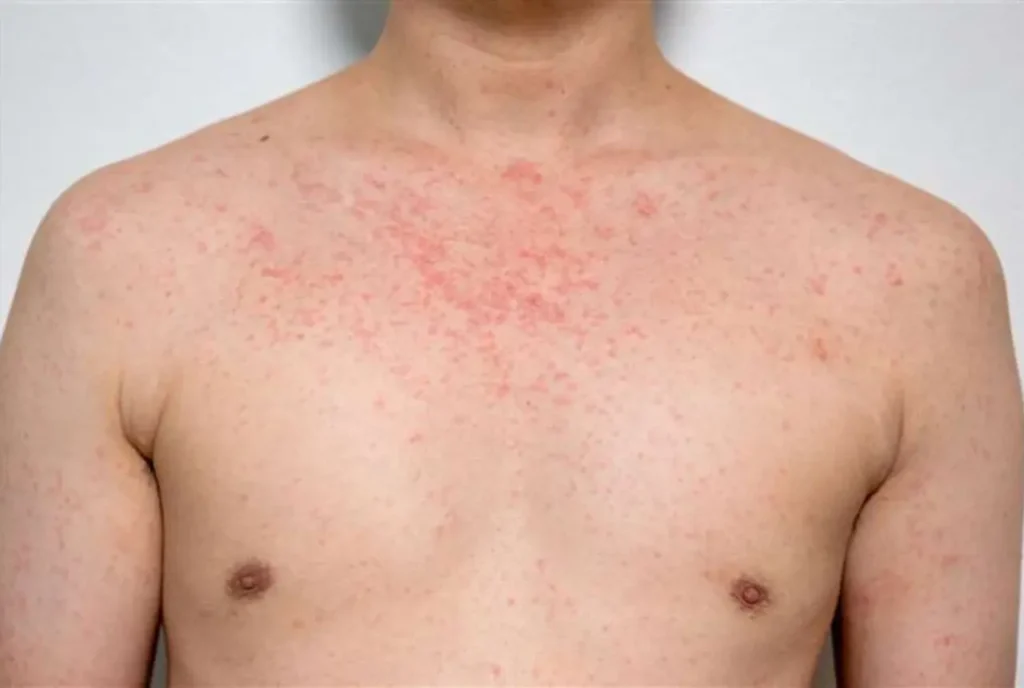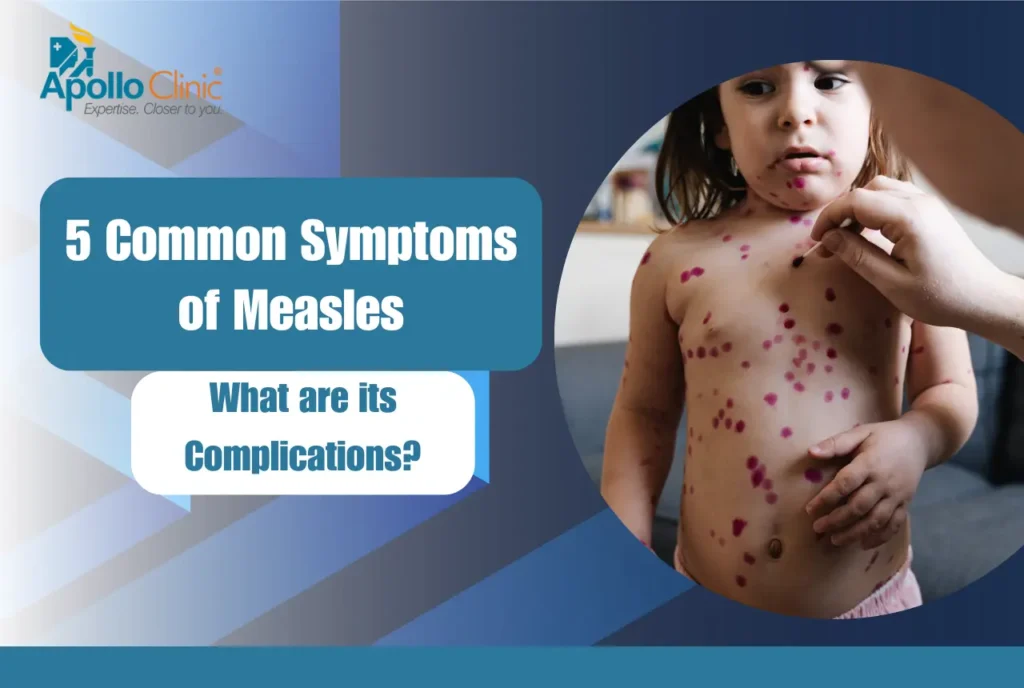5 Common Symptoms of Measles: What are its Complications?
Measles is a highly contagious viral infection that affects children. It can spread through the air when an infected person speaks.
Some of the most common symptoms of measles are fever, watery eyes, rashes, sneezes, and coughs.
To date, there is no medical treatment for measles and you have to let the virus run its course. The best protection against this virus is the measles vaccination.
Morbillivirus, an exceedingly contagious virus, causes measles.
It is an airborne disease, which means it spreads via the air whenever an infected person breathes, coughs, sneezes, or speaks.
While most people recover fully from measles, complications can arise, especially in young children and adults.
The most commonly seen symptom of measles is pneumonia. Other complications can be croup, otitis media, and diarrhea caused by secondary infections.
Measles is no longer as common as it once was. Vaccination rates are low in many places of the world.
This means that you can contract measles while traveling worldwide.
Anyone who has not been vaccinated against measles is in danger of contracting it. Measles is sometimes known as rubeola, 10-day measles, or scarlet measles.
Common Symptoms of Measles
The measles symptoms takes up to 12 days of exposure to the virus to show symptoms. Many other cases have also surfaced where the early symptoms of measles have developed only after 21 days.
1. Fever

Measles is commonly identified with high fever as an early symptom.
It typically reaches around 40°C. This fever can appear suddenly or develop gradually over a few days.
The fever can be brought down with the help of over-the-counter medicine like paracetamol or ibuprofen and it can also aid in the body ache that accompanies the high fever.
2. Measles Rash

The measles rash is a telltale symptom and the most crucial sign for diagnosis.
It usually appears 3 to 5 days after the initial fever.
The rash starts as small, red, flat spots on the face, often around the hairline but it can spread to other parts of the body as well.
Over a few days, these spots will grow into raised bumps and spread down the body, reaching the arms, legs, and feet.
The measles rash typically lasts for about 4-7 days. The measles rash spots are occasionally elevated and create blotchy areas.
They don’t normally itch. The rash appears brown or red on white skin. Small raised bumps may also form on top of the flat red areas.
The rash itself lasts approximately seven to ten days.
Other measles symptoms may include a sore throat and fever that may go away in a few days as well.
3. Cough and Runny Nose

Another important symptom to identify in measles along with high fever and rash is cough and runny nose.
The viral infection causes a cough and a runny nose as the infection spreads to the lungs.
This is how the virus spreads to other people when an infected person coughs.
It might produce a variety of respiratory issues, including chronic obstructive pulmonary disease, pneumonia, and the later development of chronic suppurative lung disease, giant cell pneumonia, or progressive respiratory insufficiency.
4. Koplik Spots
Koplik’s spots are 1-3 mm grayish or bluish elevations with an erythematous foundation that appear on the buccal mucosa, generally opposite the molars but occasionally on the labial mucosa. They have been described as ‘ salt grains on a red background’.
5. General Malaise and Listlessness
A general malaise and listlessness follow measles during the viral infection. The infected person feels energy-less and listless throughout the day.
Measles Complications
While measles typically begins with a fever and rash, it can cause more than just mild inconveniences. Here’s a breakdown of the complications you should know about:
Minor Threats: Measles can cause ear infections and diarrhea, which are distressing but curable. However, it is critical to manage them to avoid further difficulties and promote sufficient hydration, particularly in young children.
Serious Threats: If any of the following occur, get emergency medical attention:
- Pneumonia is a lung illness caused by either the measles virus or bacteria that take advantage of a compromised immune system.
- Encephalitis is a dangerous condition that can cause brain injury when the virus spreads to the brain.
- Subacute Sclerosing Panencephalitis (SSPE) is a rare but lethal consequence of measles that causes gradual brain degeneration years after the infection.
- Pregnancy Risks: Measles during pregnancy can be harmful to both mother and baby, perhaps resulting in early birth and low birth weight.
Measles in Adults vs. Measles in Children

While measles is commonly believed to affect only children, adults are also susceptible to it. Here are the differences between measles in adults vs children.
Severity of Symptoms
While children get all the symptoms of measles as adults, they often have a milder impact compared to adults. Their developing immune system helps them recover well from the virus.
Adults on the other hand may experience more severe symptoms like high fever, and severe cough, and are also more susceptible to the risks associated with the disease.
Recovery
Children tend to recover faster and better from the virus than adults due to their growing immunity.
Adults take a little longer than children to recover, especially the ones with complications.
While measles can affect both children and adults, the symptoms can be very different.
Adults are more likely to experience severe problems since their immune systems are stronger. Vaccination remains the most effective strategy to avoid measles and its consequences in all age groups.
Difference Between Measles and Rubella
Though Rubella and Measles cause the same kind of rash, there are some key differences between them.
| Feature | Measles | Rubella |
| Virus | Paramyxoviridae family | Rubivirus family |
| Severity | More severe | Milder |
| Symptoms | High fever, cough, light sensitivity, Koplik spots, widespread rash | Low-grade fever, headache, sore throat, fine pink rash |
| Complications | Pneumonia, encephalitis, SSPE | Less frequent, birth defects in pregnancy |
| Transmission | Highly contagious (airborne) | Contagious (airborne, less than measles) |
| Prevention | MMR vaccine | MMR vaccine |
Measles Prevention and Treatment

Measles Vaccination
The measles vaccine prevents infection with measles. Almost everyone who does not develop immunity after the first dose develops it after the second.
When a population’s vaccination rate exceeds 92%, measles outbreaks are rare; but, if vaccination rates fall, outbreaks may reoccur.
The vaccine is generally safe, even for HIV-infected individuals. Most children do not have any side effects; those who do are usually moderate and temporary, such as fever, rash, soreness at the injection site, and joint stiffness.
Measles Treatment
There is no cure for measles to date. The best protection against it is immunization through the MMR Vaccine.
Therefore, usually, people recover from the virus once the virus has run its course and if there are no complications stemming from it.
But, medication can help with the symptoms like paracetamol or ibuprofen for fever and pain.
Measles Outbreak Information
You can easily find measles outbreak information on the internet and websites like Centres for Disease Control and Prevention.
In Closing
Measles used to affect millions of children around the world before the vaccination. But now it has been controlled. Therefore, the best way to tackle measles is to get vaccinated.
If you think you have measles and see the above-mentioned symptoms, seclude yourself to prevent it from spreading to other people. If you have any complications after measles, consult our experts at Apollo Clinic Silchar.





